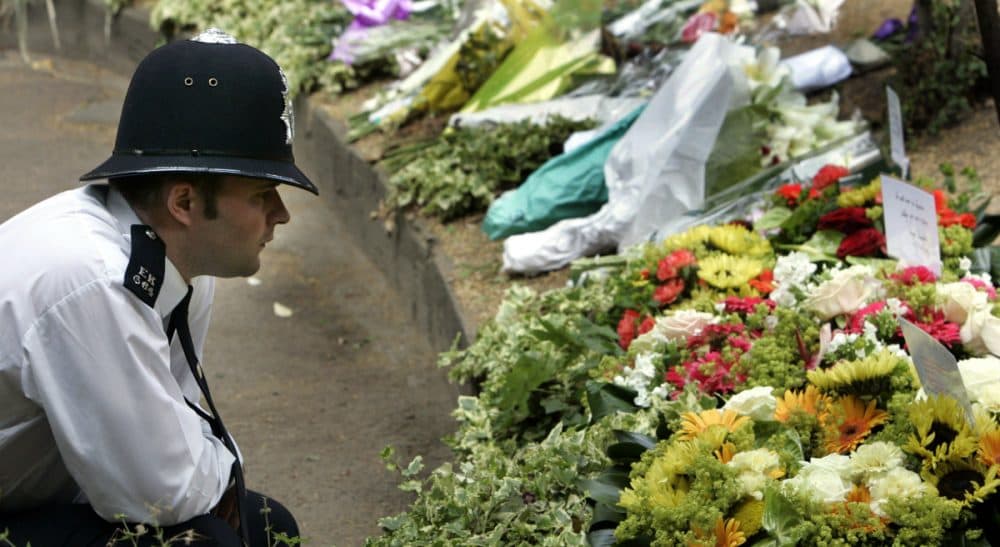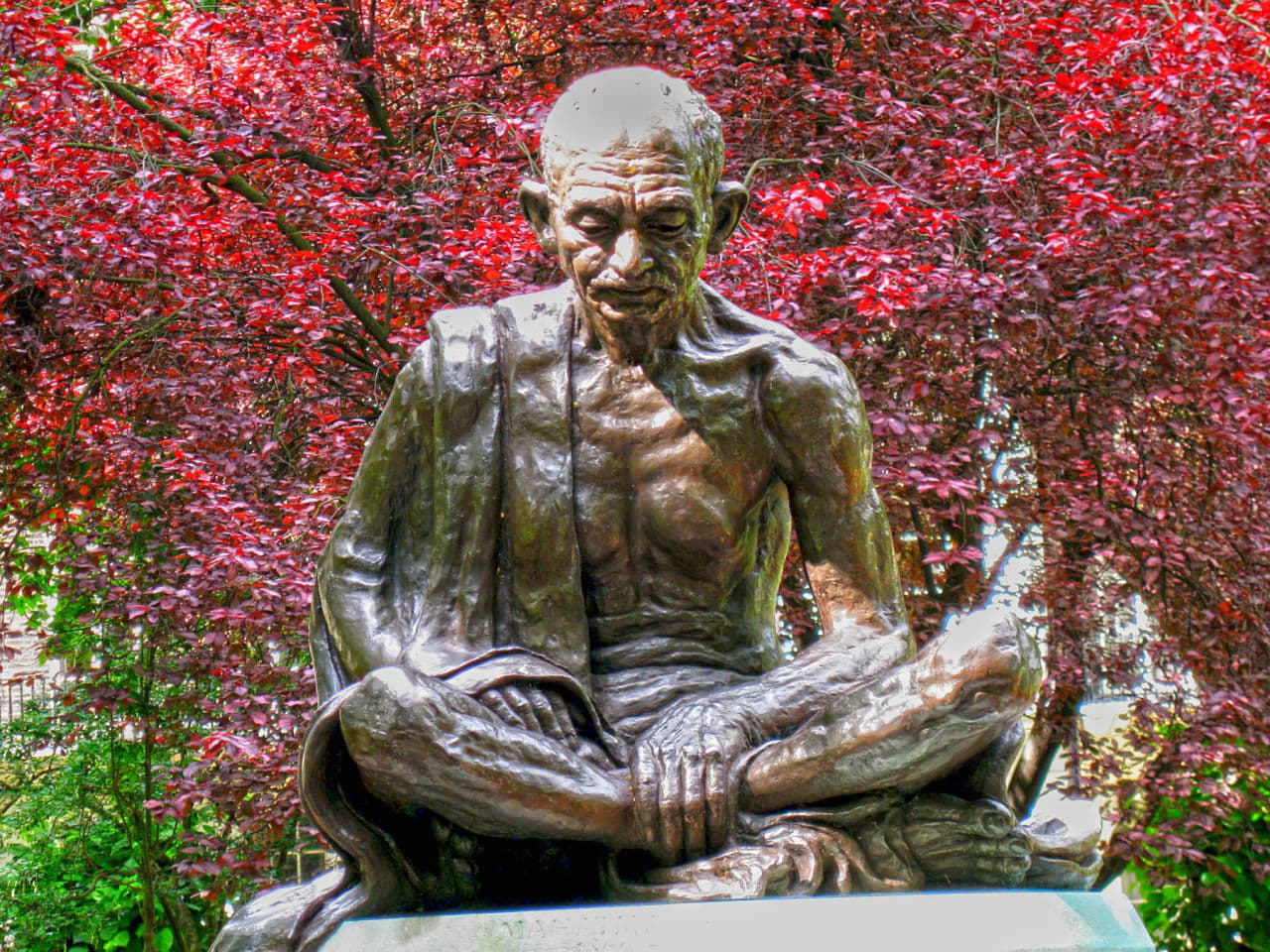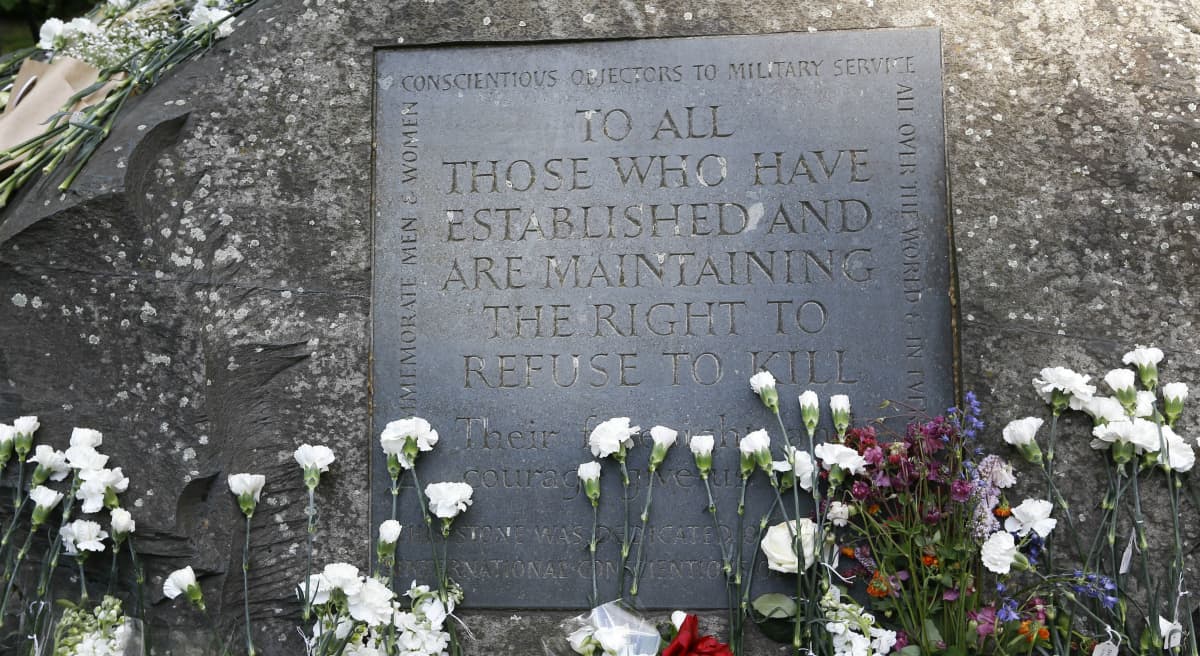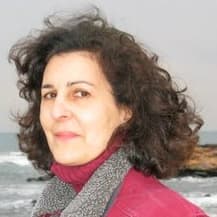Advertisement
Tavistock Square: A Decade After Terror, A Reminder Of Peace

Some may know London's Tavistock Square only as an image flashed across their television screens 10 summers ago, when suicide bombers exploded a bomb on a double-decker bus there, killing 13 people and injuring many others. (Three other bombs, on the London Underground, killed 39 more people and injured 700 others that day.)
...for more than half a century, this leafy Georgian square in the heart of literary Bloomsbury has honored the lives of those who work for peace.
Yet for more than half a century, this leafy Georgian square in the heart of literary Bloomsbury has honored the lives of those who work for peace — ever since independent India's first Prime Minister, Pandit Nehru, planted a copper beech tree in the gardens on June 13, 1953. The occasion marked the donation of an adjacent spot for a larger-than-life monument to another man of peace, Mohandas Gandhi. Nehru's beech has since been replaced, but the statue of a seated Gandhi continues to draw Londoners and visitors, alike. On a recent visit, people heaped fresh flowers in Gandhi's bronze lap. The sculpture, by Fredda Brilliant, dominates Tavistock Square's Gardens, a 2.5-acre park and a central part of any London “peace walk.” No one knows for sure, not even local historians, how the martyred Indian leader found a home here. It may simply be that Gandhi studied law at the nearby University College, London.

But Gandhi’s statue, dedicated in 1968, has set the tone for the plantings and installations that have followed: a flowering cherry tree planted on August 6, 1967 in memory of the victims of Hiroshima; a bench donated by Mothers for Peace; and a mammoth slate stone, unveiled on May 15, 1994, International Conscientious Objectors' Day, and remembering "all those who have established and are maintaining the right to refuse to kill."
Since its dedication in 2004, a new bronze casting of Stephen Tomlin's famous bust of Virginia Woolf has rested on a stone pedestal at the southwest corner of the gardens.The statue's deep-set eyes suggest a melancholy, inward gaze.
Woolf lived overlooking the park, at 52 Tavistock Square, and wrote her most celebrated novels there, including "Mrs. Dalloway" and "To the Lighthouse." Like many Bloomsbury intellectuals, Woolf was a pacifist; her husband, Leonard Woolf, spent much of his life working for world peace, and helped to establish the League of Nations. In their basement, the Woolfs ran the Hogarth Press, publishing T.S. Eliot's "The Wasteland" and the works of Sigmund Freud.
On her walks around the square, Woolf, whose own bust is modest in scale (it stands at eye level), would have passed one that towers over the southeast side of the gardens: The monument to Louisa Brandreth Aldrich-Blake, one of Britain's first women surgeons, is a double-faced bust erected high over a stone bench. One face looks toward the traffic, an ever-present clutch of red double-decker buses along Upper Woburn Place; the other surveys the more serene gardens. The sculpture, by A.G. Walker, is perched so high, the leaves of a tall London plane tree brush the subject's face. Across the street is the British Medical Association, where doctors and nurses rushed to save victims of the 2005 bombing, a reminder of the delicate balance between life and death, violence and healing, that have come to characterize Tavistock Square.

This square celebrates peace in its memorials, yet most of the surrounding buildings were destroyed by Nazi bombs. House fronts were ripped away, roofs torn off, and interiors exposed to the elements. Virginia Woolf suffered anguish upon returning to London and seeing the remains of her once solid brick house--the roof gone and the murals painted by her sister, Vanessa Bell, and Bell's partner, Duncan Grant, opened to the sky. It was one of Woolf's last views of London, only months before she died on March 28, 1941. Her grief over the war contributed to her suicide.
The graceful wrought-iron railings that once enclosed these and other London gardens are gone, as well, melted down for World War II weapons and later replaced by cruder railings. Only one side of Tavistock Square was spared devastation--the west. It supports the London stock brick houses, now blackened by age and soot, but elegant in their simplicity and uniformity, buildings with pilasters, columns and terraces revealing the Georgian and Regency architecture for which Bloomsbury is known.
This square celebrates peace in its memorials, yet most of the surrounding buildings were destroyed by Nazi bombs.
Nowadays, on bright summer evenings, young men play soccer on a green that once supported a tennis court. Across the way, on a field near the Conscientious Objectors' Stone, a boy tosses a boomerang and catches it; his grandfather looks up from a book and nods with approval. The huge plane trees provide shade and filter light that falls on the face of a woman reading and on the hands of a man sitting alone on a nearby bench as he opens the evening paper.
Tavistock Square has always been an urban sanctuary, a crucial part of a neighborhood of intellectual and literary vitality, ever since the gardens were created and the first houses constructed around its perimeter. It has also endured war and terrorism, yet it stands as a curious and inspiring place that celebrates life over death, civilization over destruction, peace over war.
